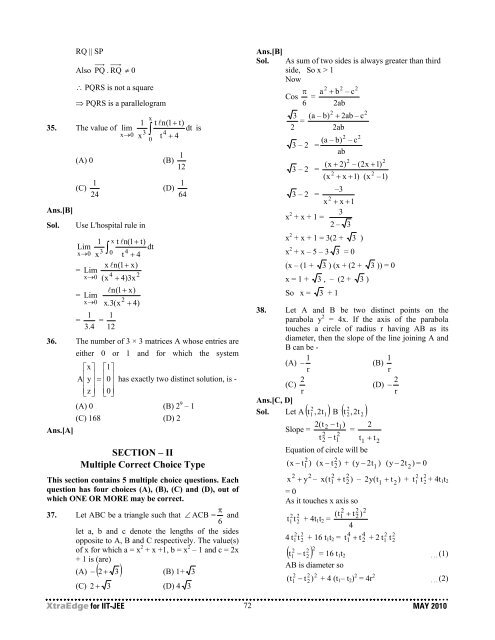You also want an ePaper? Increase the reach of your titles
YUMPU automatically turns print PDFs into web optimized ePapers that Google loves.
RQ || SP<br />
Also PQ . RQ ≠ 0<br />
∴ PQRS is not a square<br />
⇒ PQRS is a parallelogram<br />
35. The value of<br />
Ans.[B]<br />
Sol.<br />
x lim →0<br />
t ln(1<br />
+ t)<br />
dt<br />
3 ∫<br />
is<br />
4<br />
t + 4<br />
x1 x 0<br />
(A) 0 (B) 12<br />
1<br />
1<br />
(C) 24<br />
Use L'hospital rule in<br />
1 t ln(1<br />
x +<br />
Lim<br />
x → 0 3 ∫ 0 4<br />
x t + 4<br />
x ln(1<br />
+ x)<br />
= Lim<br />
x → 0 4 2<br />
+<br />
= Lim<br />
=<br />
(x<br />
4)3x<br />
ln(1<br />
+ x)<br />
x<br />
x → 0 .3(x<br />
2 + 4 )<br />
1 1 =<br />
3.4 12<br />
t)<br />
dt<br />
1<br />
(D) 64<br />
36. The number of 3 × 3 matrices A whose entries are<br />
either 0 or 1 and for which the system<br />
⎡x⎤<br />
⎡1⎤<br />
A<br />
⎢ ⎥<br />
=<br />
⎢ ⎥<br />
⎢<br />
y<br />
⎥ ⎢<br />
0<br />
⎥<br />
has exactly two distinct solution, is -<br />
⎢⎣<br />
z⎥⎦<br />
⎢⎣<br />
0⎥⎦<br />
(A) 0 (B) 2 9 – 1<br />
(C) 168 (D) 2<br />
Ans.[A]<br />
SECTION – II<br />
Multiple Correct Choice Type<br />
This section contains 5 multiple choice questions. Each<br />
question has four choices (A), (B), (C) and (D), out of<br />
which ONE OR MORE may be correct.<br />
37. Let ABC be a triangle such that ∠ ACB = 6<br />
π and<br />
let a, b and c denote the lengths of the sides<br />
opposite to A, B and C respectively. The value(s)<br />
of x for which a = x 2 + x +1, b = x 2 – 1 and c = 2x<br />
+ 1 is (are)<br />
(A) − ( 2 + 3)<br />
(B) 1+ 3<br />
(C) 2 + 3<br />
(D) 4 3<br />
Ans.[B]<br />
Sol.<br />
As sum of two sides is always greater than third<br />
side, So x > 1<br />
Now<br />
2 +<br />
π a b – c<br />
Cos = 6 2ab<br />
(a – b) 2ab – c<br />
=<br />
23 2 +<br />
2ab<br />
2 2<br />
(a – b) – c<br />
3 – 2 =<br />
ab<br />
3 – 2 =<br />
(x<br />
2<br />
(x + 2)<br />
2<br />
2<br />
2<br />
+ x + 1)<br />
2<br />
– (2x + 1)<br />
(x<br />
2<br />
2<br />
–1)<br />
–3<br />
3 – 2 =<br />
2<br />
x + x + 1<br />
x 2 + x + 1 =<br />
3<br />
2 – 3<br />
x 2 + x + 1 = 3(2 + 3 )<br />
x 2 + x – 5 – 3 3 = 0<br />
(x – (1 + 3 ) (x + (2 + 3 )) = 0<br />
x = 1 + 3 , – (2 + 3 )<br />
So x = 3 + 1<br />
38. Let A and B be two distinct points on the<br />
parabola y 2 = 4x. If the axis of the parabola<br />
touches a circle of radius r having AB as its<br />
diameter, then the slope of the line joining A and<br />
B can be -<br />
1<br />
1<br />
(A) − (B)<br />
r<br />
r<br />
2<br />
2<br />
(C) (D) −<br />
r r<br />
Ans.[C, D]<br />
2<br />
2<br />
Sol. Let A ( t 1 ,2t1)<br />
B ( t 2,2t<br />
2 )<br />
2(t<br />
Slope =<br />
2 − t1)<br />
2<br />
=<br />
2 2<br />
t 2 − t1<br />
t 1 + t 2<br />
Equation of circle will be<br />
2 2<br />
(x − t1<br />
) (x − t 2)<br />
+ ( y − 2t1<br />
) ( y − 2t<br />
2)<br />
= 0<br />
2 2 2 2<br />
x + y – x(t1 + t 2)<br />
– 2y(t1 + t 2)<br />
+ 2 2<br />
t 1 t 2 + 4t 1 t 2<br />
= 0<br />
As it touches x axis so<br />
2 2 2<br />
2 2 (t t )<br />
t 1 t 2 + 4t 1 t 2 =<br />
1 + 2<br />
4<br />
2 2<br />
4 4 2 2<br />
4t 1 t 2 + 16 t 1 t 2 = t 1 + t 2 + 2 t 1 t 2<br />
2 2<br />
( ) 2<br />
t1 − t 2 = 16 t 1 t 2 . . . (1)<br />
AB is diameter so<br />
2 2 2<br />
1 t 2)<br />
( t − + 4 (t 1 – t 2 ) 2 = 4r 2 . . . (2)<br />
XtraEdge for <strong>IIT</strong>-<strong>JEE</strong> 72<br />
MAY 2010

















